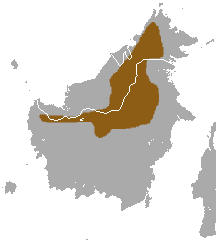Mountain treeshrew: Difference between revisions
JonRichfield (talk | contribs) Added refs and links to mutualism. |
Mgiganteus1 (talk | contribs) copyedit, moved refs inline |
||
| Line 19: | Line 19: | ||
}} |
}} |
||
The '''mountain treeshrew''' ('''''Tupaia montana''''') is a species of [[treeshrew]] in the [[Tupaiidae]] family |
The '''mountain treeshrew''' ('''''Tupaia montana''''') is a species of [[treeshrew]] in the [[Tupaiidae]] family that is [[Endemism|endemic]] to [[Borneo]].<ref name=iucn/> It has a [[mutualism|mutualistic]] relationship with certain species of giant [[pitcher plant]]s. |
||
==Range and habitat== |
==Range and habitat== |
||
| Line 30: | Line 30: | ||
==Diet== |
==Diet== |
||
The mountain treeshrew eats fruit, seeds, and leaves, and will sit back on its haunches to eat, holding the food in both forepaws, like a squirrel or gerbil. It also eats insects.<ref name=M /> |
|||
It has a mutualistic relationship with giant pitcher plants such as Nepenthes lowii, Nepenthes |
It has a mutualistic relationship with giant pitcher plants such as ''[[Nepenthes lowii]]'', ''[[Nepenthes macrophylla]]'', and ''[[Nepenthes rajah]]''; the treeshrews defecate into the plants' traps while visiting them to feed on sweet, fruity secretions from glands on the pitcher lids.<ref>Greenwood, M., C. Clarke, C.C. Lee, A. Gunsalam & R.H. Clarke (2011). A unique resource mutualism between the giant Bornean pitcher plant, ''Nepenthes rajah'', and members of a small mammal community. ''PLoS ONE'' '''6'''(6): e21114. {{DOI|10.1371/journal.pone.0021114}}</ref><ref>Chin, L., J.A. Moran & C. Clarke 2010. Trap geometry in three giant montane pitcher plant species from Borneo is a function of tree shrew body size. ''New Phytologist'' '''186''' (2): 461–470. {{DOI|10.1111/j.1469-8137.2009.03166.x}}</ref><ref>Walker, M. 2010. [http://news.bbc.co.uk/earth/hi/earth_news/newsid_8552000/8552157.stm Giant meat-eating plants prefer to eat tree shrew poo]. ''BBC Earth News'', March 10, 2010.</ref> |
||
==Reproduction== |
==Reproduction== |
||
| Line 39: | Line 39: | ||
==References== |
==References== |
||
{{reflist}} |
{{reflist}} |
||
* Chin, L., J.A. Moran & C. Clarke 2010. Trap geometry in three giant montane pitcher plant species from Borneo is a function of tree shrew body size. ''New Phytologist'' '''186''' (2): 461–470. {{DOI|10.1111/j.1469-8137.2009.03166.x}} |
|||
* Walker, M. 2010. [http://news.bbc.co.uk/earth/hi/earth_news/newsid_8552000/8552157.stm Giant meat-eating plants prefer to eat tree shrew poo]. ''BBC Earth News'', March 10, 2010. |
|||
{{Scandentia}} |
{{Scandentia}} |
||
Revision as of 23:38, 5 July 2012
| Mountain treeshrew[1] | |
|---|---|
| Scientific classification | |
| Kingdom: | |
| Phylum: | |
| Class: | |
| Order: | |
| Family: | |
| Genus: | |
| Species: | T. montana
|
| Binomial name | |
| Tupaia montana Thomas, 1892
| |

| |
| Mountain treeshrew range | |
The mountain treeshrew (Tupaia montana) is a species of treeshrew in the Tupaiidae family that is endemic to Borneo.[2] It has a mutualistic relationship with certain species of giant pitcher plants.
Range and habitat
It is found in Borneo, and lives in montane forest.[3]
Description
It has a long, bushy tail, and a slender, pointed snout. The body length is 11–15 cm, and the tail length 10–15 cm.[3]
It spends much of its time on the ground, although it is agile in the trees. This species is thought to be slightly more social than others of its genus and may live in small groups.[3]
Diet
The mountain treeshrew eats fruit, seeds, and leaves, and will sit back on its haunches to eat, holding the food in both forepaws, like a squirrel or gerbil. It also eats insects.[3]
It has a mutualistic relationship with giant pitcher plants such as Nepenthes lowii, Nepenthes macrophylla, and Nepenthes rajah; the treeshrews defecate into the plants' traps while visiting them to feed on sweet, fruity secretions from glands on the pitcher lids.[4][5][6]
Reproduction
Breeding takes place at any time of year, and a litter, normally of 2 young, is born after a 49 to 51 day gestation period.[3]
References
- ^ Gardner, A. (2005). Wilson, D.E.; Reeder, D.M. (eds.). Mammal Species of the World: A Taxonomic and Geographic Reference (3rd ed.). Johns Hopkins University Press. p. 107. ISBN 978-0-8018-8221-0. OCLC 62265494.
- ^ a b Template:IUCN2008
- ^ a b c d e Macmillan Illustrated Animal Encyclopedia.
- ^ Greenwood, M., C. Clarke, C.C. Lee, A. Gunsalam & R.H. Clarke (2011). A unique resource mutualism between the giant Bornean pitcher plant, Nepenthes rajah, and members of a small mammal community. PLoS ONE 6(6): e21114. doi:10.1371/journal.pone.0021114
- ^ Chin, L., J.A. Moran & C. Clarke 2010. Trap geometry in three giant montane pitcher plant species from Borneo is a function of tree shrew body size. New Phytologist 186 (2): 461–470. doi:10.1111/j.1469-8137.2009.03166.x
- ^ Walker, M. 2010. Giant meat-eating plants prefer to eat tree shrew poo. BBC Earth News, March 10, 2010.

